Board condition
When choosing a paint and varnish composition for painting a gazebo made of wood, it is imperative to take into account the condition of the wooden boards. Experts say that the condition of the boards is one of the key points that has a great influence on the choice of a particular paint. Wood planks can be in one of the following states:
new, polished. If the tree is smooth and even, then the best option is not to paint it with paint, but to treat it with wood stain, clear varnish or some other tinting material. New, polished wood looks very solid and beautiful, when its structure is emphasized by a transparent paint and varnish material, it perfectly emphasizes the pattern of a board, log or bar, and creates a reliable protective coating. In some cases, a transparent antiseptic substance can be used for treatment;
raw boards. When the tree is poorly planed, it is better not to cover it with a transparent paint and varnish solution. If you paint it from untreated wood with a stain or varnish, then the solution will certainly not lie in an even layer. On smooth areas, the coating will be shiny, and rough areas will become dull, in addition, ugly stains will remain from the roller or brush.
The best option than to paint such a gazebo is to use non-transparent paint, which is important to apply by spraying from a spray gun;
old, burnt out, darkened wood. It is best to paint such wood with an opaque paint and varnish material, it will hide all existing defects under it;
previously painted but lost its original beauty wooden structure
If the old coating will not be removed, and the new paint will be applied over the old paint and varnish layer, then it is important to choose a type of paint that will be identical in composition to the one that was applied earlier. However, experts do not recommend painting a wooden gazebo in this way, since the remnants of the old coating will reduce the adhesion rate and the protective characteristics of the new finishing material.
If you paint with new paint on top of the old one, then soon, due to the adverse effects of atmospheric factors and other negative manifestations, the decorative layer will peel off. Professional painters strongly recommend completely removing the old paintwork from the tree, and then treating the surface with special protective substances.
What color to choose for painting the gazebo in the country
The variety of colors on offer often makes it difficult to choose the right one. It is best to use the advice of experts in this matter.
Experts advise to paint the alcove so that after that it will be in harmony with the buildings located on the site - the house and other outbuildings. At the same time, you should not get carried away with bright colors, as the main ones.

Varnish is a good solution. It emphasizes the texture of the wood, which is better tinted with a stain beforehand, but you can not do this. The lacquer coating is suitable for cladding new wooden parts and gazebo floors.
Read about the use of various small architectural forms in site landscaping.
There are several popular design solutions for dyeing an arbor with decorative dyes:
- Classic white version. It visually enlarges the interior space, giving the structure a novelty look. Experts recommend a white finish for lattice structures. The disadvantage of this variation will be constant care, since dirt is very noticeable on a white background.
- Coating with warm shades of paint (yellow, ocher, etc.).This option is suitable for gazebos built of imperfect timber in order to hide its poor quality and at the same time bring the color of the building closer to natural.
- A popular variation was painting the gazebo with blue or green colors. Skillfully selected shades will help to create a harmonious exterior that fits well with the color scheme of garden plants and flowers.
- The black color, despite its severity and lack of color scheme, is quite often used to paint gazebos.
- Bright paints are often used to paint children's gazebos, as well as to contrast some details and furniture inside the arbours - panels, tabletops, chairs, benches, etc.
Features of the color palette
Many people wonder what color it is better to paint the gazebo in the country. Experts first of all consider the unique possibilities of the palette. For example, if the owners want to visually expand the space, white paint will do. This color automatically creates a novelty effect. True, the dirt on such surfaces is visible from afar. All 136 shades of yellow, including laser lemon, imitate warm tones in the best way. Therefore, if it is necessary to paint wood with noticeable cracks along the grain, this is the best that can be offered to consumers.
Cool shades of blue and green are ideal for painting roofs and walls outside. In this case, the colors of living decorations and annexes will complement each other. For facing work, experts recommend black. It makes the space deeper, and in combination with red and crimson shades it overcomes the feeling of gloom.
If you need to beautifully paint a baby gazebo, give preference to:
- Orange color that encourages children to physical activity. A juicy orange warms up a sense of confidence, thanks to which the child learns the material faster, and most importantly, is not afraid to learn the world by trial and error.
- A yellow palette that promotes the development of intuition.
- Soothing shades of blue.
- Red with the addition of yellow and green tones. In its pure form, this color invigorates, but causes aggression.
- Violet, under the influence of which you can improve the imagination and even speed up the thought process.
High-quality painting of wooden floors, window openings and outdoor stairs is possible only after appropriate surface preparation. First, you need to remove the old varnish from them, wash off the dust and dirt. A construction hairdryer will help with this. If paint is not removed, no further action is required. It is enough to grind the surface with sandpaper and dry it thoroughly.
 Depending on the purpose of the gazebo - choose a color
Depending on the purpose of the gazebo - choose a color
At the next stage, you need to degrease the canvas, and if scratches and slopes are visible on it, use a putty. For the best result, it is useful to treat the wooden surface with an acrylic primer. It fills the pores well, doubling the shelf life of products made from natural materials.
It is advisable to apply the paint with uniform movements in three layers. Each of them dries for at least 25 minutes. Complete drying is possible only after 3 hours.
Types of paints and protective coatings
Coatings can be divided into two groups: transparent and dense.

The gazebo primer is a preparation for the main stage of painting.
Transparent coatings
Primers
Modern synthetic resins make it possible to obtain high-quality paints and varnishes diluted with hydrocarbon solvents and water. These include coatings and impregnations acrylic based, latex, stains, drying oils.
Water based primers 1. Latex. Deep penetration soil. Permeates vapors (allows the material to "breathe"), but impervious to water. Excellent preparation of the wood surface for subsequent painting: increases adhesion, binds dust particles. In arbors, it is used for priming wooden floors.
2.Deep penetration acrylic primers for preparing wood for painting contain antiseptics to protect against mold, fungi and reduce paint consumption.
3. Stains. Alcoholic compositions with a minimum amount of high-fineness pigment. Ideal for smooth, sanded surfaces. They fall badly on the ground. Requires a transparent protective layer.
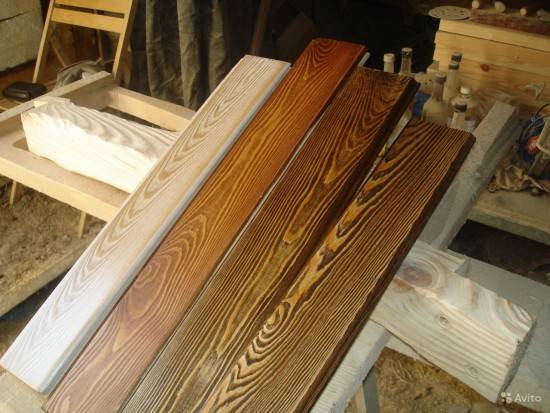
The stain adheres perfectly to smooth, sanded surfaces.
Oil and varnish primers
1. Drying oils. Sometimes used as a stand-alone coating. This is a mistake: drying oils are a good preparatory layer, retain some stickiness, which makes it possible to more reliably adhere to films of oil paints. But without an additional layer, wooden surfaces soon become "overgrown" with a layer of dust, have an unpleasant, sticky and dirty surface.
2. Primers like Pinotex. Produced by two companies (Estonia and Finland). The coating is based on alkyd resin and tinting pigments. It is used only on special primer.
The chemical composition is important: some types of Pinotex contain pentachlorophenol and are suitable only for external use. In Russia it is often used as an independent coating, but without a special primer. In this case, it is short-lived, peels off after 1-2 years.
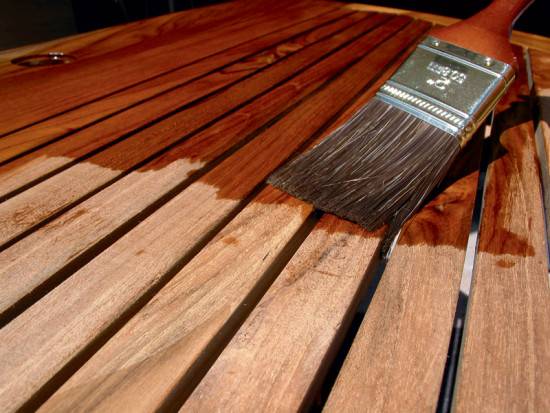
Oil and varnish primers are used only on special primers.
Varnishes are made from resins and oils with the addition of solvents, stabilizers and desiccants, which accelerate drying:
1. XB tinting varnishes. Not the best option for wood, although it is popular because of its convenient packaging (it is sold in transparent half-liter bottles, it looks beautiful). Each next layer dissolves and carries the previous one behind the brush. It is very difficult to lay the XB varnish evenly. It contains toluene. Extremely toxic.
In direct contact with water, it exfoliates from the surface, becomes cloudy, whitish. It is not recommended to paint over such a varnish with a coating of a different composition.
2. Yacht and parquet alkyd varnishes. Colorless waterproof coatings of varying gloss levels
It is worth paying attention to the presence of UV filters - special additives that increase the protection of resins from the effects of ultraviolet radiation from the Sun.
Transparent and glazing (translucent) coatings can only be applied to fresh, clean wood.

Wood varnishes are most often colorless water-resistant coatings of varying degrees of gloss.
Body (opaque) coatings
For dense coloring of wooden surfaces, the usual alkyd enamels for outdoor work and modern paints on polymer binders are used. All of them have unique advantages:
1. Acrylic. The binder is an acrylic copolymer. These paints are highly durable. The thinner is water. Therefore, acrylic paint is extremely environmentally friendly. Latex additives to acrylic resins allow to obtain a more elastic film. Latex paints are resistant to dry abrasion, water. Acrylic and latex paints can be applied to any substrate, regardless of the composition of the previous paint.
2. Silicone. Silicone resin based paints. They have a higher water resistance while maintaining vapor permeability. When dry, the electrostaticity of the paint film becomes neutral. Therefore, dust particles are not retained on it. The paint belongs to the self-cleaning group and is one of the most durable paints. Quite expensive, though.
3. Silicate. Liquid potash glass is used as a binder. The paint has maximum water resistance. However, it should not be applied to surfaces previously painted with acrylic or silicone paint.
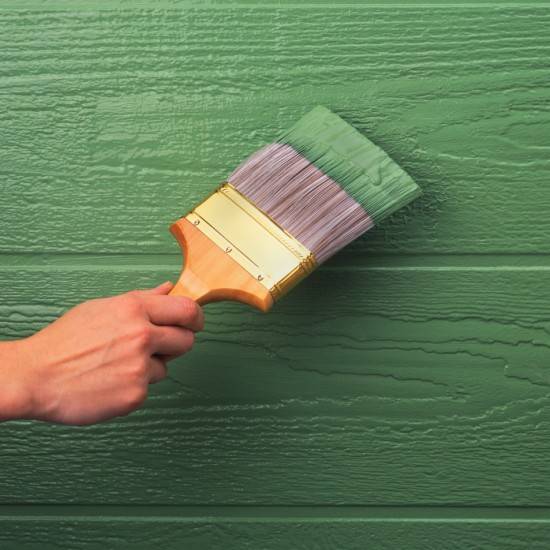
Latex additives to acrylic resins provide a more flexible film.
4. Alkyd. Paints based on pentaphthalic (PF) or glyphthalic (GF) varnishes. They are characterized by high strength and weather resistance. Diluted with white sperit. Some of the most reliable are Finnish (and the most expensive).
Covering the floor of the gazebo with varnish or mastic
The wood of the floor is protected with varnish or mastic if they want to preserve the natural beauty of the material. They are even used on non-valuable wood species such as pine, poplar, elm.
Mastics
There are several types of mastics, classified by chemical composition and application temperature:
1. Hot mastics. Bituminous and rubber compounds. They are applied hot (temp. 160-180 degrees), harden as they cool. However, it is difficult to warm them up at home.
Flammable: they can catch fire directly at the time of heating.
2. Cold mastics. Most mastics are applied unheated:
- Water soluble. Contact of wood with water is highly undesirable. Therefore, such mastics are used mainly on dense wood species.
- Water-based. Convenient and practical: easily applied to any type of wood, easy to work with, versatile. Includes anti-static additives to make the coating self-cleaning.
- Turpentine. Artificial waxes (paraffin, stearin) and resins with targeted additives. Diluted with turpentine.
- Wax. Beeswax mastics. Versatile - suitable for any type of wood. Diluted with turpentine.
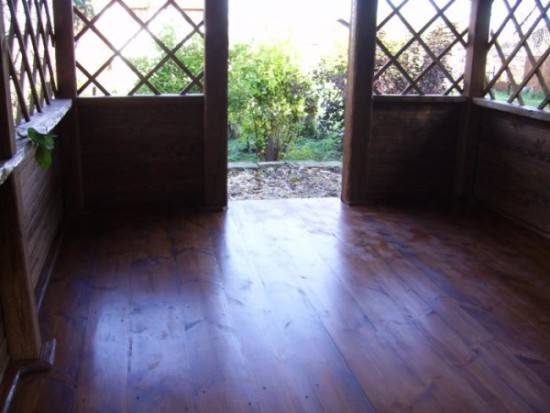
Floor mastic is ideal when you want to preserve the natural beauty of the material.
Mastics are not eternal. But, having served their term, they require renewal. What distinguishes them from varnishes is that a new layer is applied over the old layer. In addition, mastics require periodic rubbing, since the gloss becomes uneven (in places of greatest abrasion, it decreases, matte spots appear). Varnishes are easier to maintain.
Lucky
Varnish is a softened resin with the addition of various additives. For interior work, more environmentally friendly compounds are used. For outdoor use - resistant to water, temperature extremes and ultraviolet radiation (weatherproof).
Recommendations for correct preparation for the procedure
In order for the floor on the veranda to have a long operational life, correct preliminary preparation is very important. If the floors were previously covered with paint, it must be removed from the surface completely. To facilitate the removal of old coatings, it is better to use special products or use solvents and a spatula in the work.
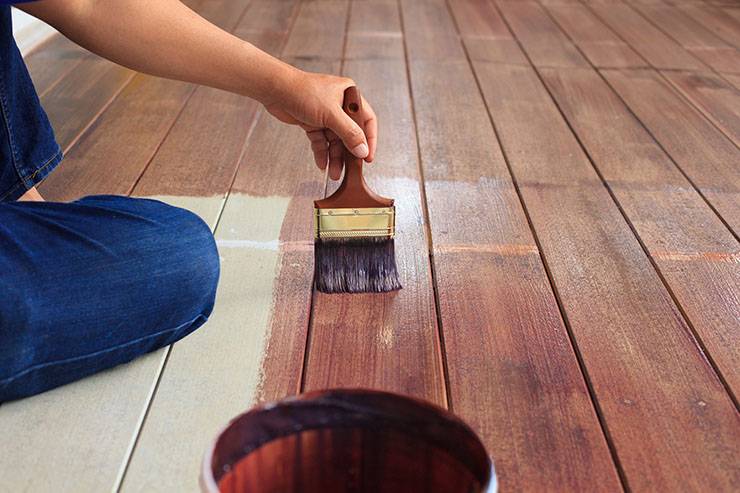 Do not forget about the nuances of painting floors
Do not forget about the nuances of painting floors
Before painting, it is very important to remove all possible defects and irregularities in the wood. Under the influence of the sun and moisture, the material acquires an ugly black and gray shade
The top layer of wood must be removed with a sander - this will help eliminate defects and bacteria. Such work is carried out until a light shade of the wooden board appears. Defective elements must be replaced as they can crack under appropriate load. All cracks and crevices in the floor must be carefully putty and sanded.
After sanding, the floors are cleaned of dust and sawdust. Only then can you start covering the boards with a protective agent. For this, you can use various materials, which differ in the method of application. If you plan to use an antiseptic primer, then the floorboards must be treated with such a composition in advance, before installation. It is recommended to cover the floors in several layers for better impregnation of the wood material. The primer must dry thoroughly, and only after complete drying is the main paint material applied.
Many owners of summer cottages and country houses have to renew the veranda or terrace flooring annually, since a very small amount of materials have the necessary degree of stability for use as flooring in open spaces.
Classification of coatings
Main types
For the flooring of the gazebo, the following categories of protective compounds can be used:
- Antiseptic substances - perfectly protect the tree from decay, preventing the development of both bacteria and fungi;
- Varnishes - form a protective film on the wood surface. Moreover, for flooring, a varnish containing fungicides is usually used. They prevent decay as well as discoloration and cracking of the boards;
- Paints - can not only protect wood from the harmful effects of moisture, but also give a presentable appearance to its surface. A variety of colors and shades will allow you to choose a covering that is suitable for the design of any gazebo.
Popular coating brands
In hardware stores, you can choose any floor covering you like for gazebos. But still, it is worth taking a closer look at those samples that are in the greatest demand among buyers.
These include the following products:
Woody healer is an antiseptic compound that can be used to treat any type of wood. It can be applied even on a wooden floor affected by a fungus. The substance is environmentally friendly and absolutely safe;
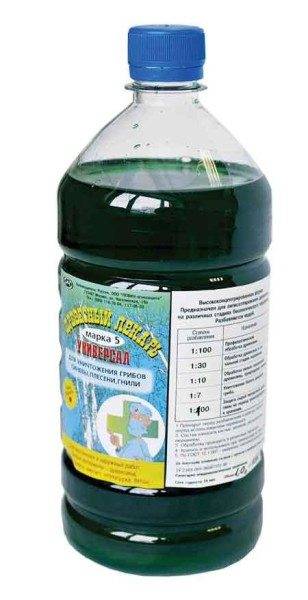
Arboreal healer
Biosept is one of the best products designed to create a protective floor covering in a gazebo using the most modern technologies. Thanks to them, the resulting surface is resistant to weathering, durable and difficult to wash. In addition, after such treatment, the floor allows subsequent staining;
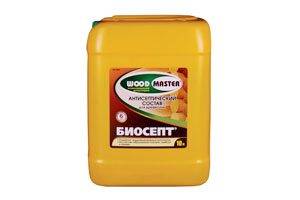
Biosept
Aquatex - can also be used to treat floors. But it is more often used for application to windows, doors and stairs;
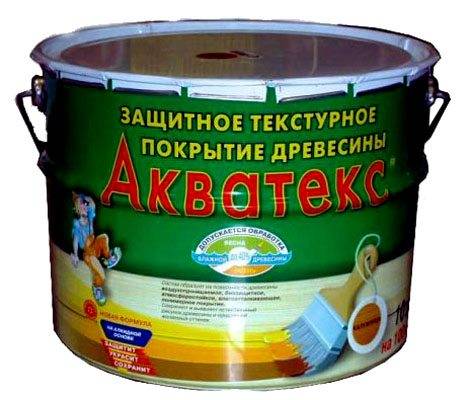
In the photo - a container with Aquatex
Elkon - under this brand, universal impregnations and products for a certain category of material are produced. Thus, the composition "Elkon Aqua Bio" is used for the treatment of floors made of freshly sawn boards.
Elkon
We have listed the most popular domestic products. But there are also excellent foreign samples. Their price is much higher than their Russian counterparts.
At the same time, the performance characteristics of these compositions are higher.
Let's list the most famous brands:
- TIKKURILA is a Finnish company that produces a full range of coatings for wooden floors;
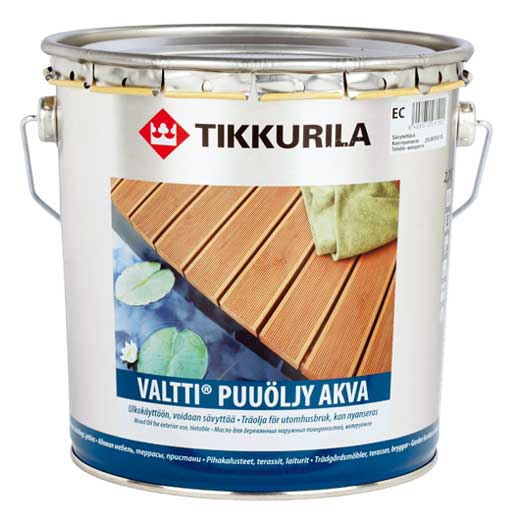
TIKKURILA
- Dulux is an English concern that produces varnishes, paints and impregnations based on organic solvents. These compositions are excellent for the treatment of wooden arbor floors. Their use makes it possible to obtain a strong and durable coating that protects the tree well from rotting and sunlight;
Dulux varnish
- ALLICATOR is a German company, the compositions of which are distinguished by deep penetration into the structure of the processed material. This makes the obtained result resistant and durable. In addition, this treatment does not clog pores and maintains the natural structure of the boards.
When choosing a specific composition, it is worth giving preference to difficult-to-wash, durable impregnations. They will provide the best protection for the boards, extending their service life up to 30-35 years.
But this only applies to expensive funds. The validity period of more accessible samples is significantly shorter and is no more than ten years.
In addition, it must be borne in mind that some drugs only counteract putrefactive processes, while others also prevent the appearance of bugs in the wood.
Third compositions are fire retardant. This means that in addition to the above, they do not allow ignition of the floor they have treated.
Variety of colorants and protective coatings
Wood-based gazebo paint has a different consistency.For work, you can use dense products or choose coatings with a transparent texture.
Dense paints and varnishes
This group includes alkyd enamels intended for painting buildings on the street, and all types of modern paints.
- acrylic compounds are based on an acrylic copolymer. They are environmentally friendly and have a high degree of strength. They can be applied to any type of coating that has previously been treated with lumber.
- silicone paints based on silicon resins are distinguished by high indicators of water resistance and vapor permeability. Self-cleaning materials create a slippery surface that does not attract dust particles. They have no drawbacks other than high cost.
- silicate products have good water resistance. The peculiarity of the technology of their use is that the paint is applied to the prepared wood without the slightest traces of the previous paint and varnish coating.
- alkyd enamels are common due to their relatively low cost and high strength. Finnish-made coloring agents are recognized as one of the highest quality products.
The processing of a wooden gazebo with paints allows you to create a unique design of the structure - their color range is striking in its variety.
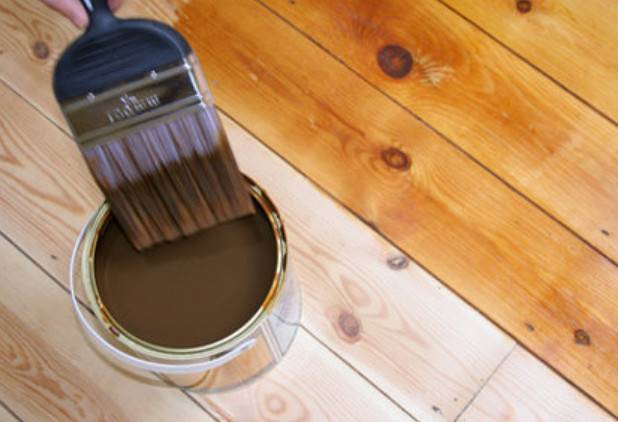
Transparent primer coats
Soil compositions, depending on the stages of lumber processing, are of several types:
- latex primer for deep penetration. Breathable but impervious to water, perfect for covering wood before painting. Floor covering in a gazebo is often done with latex primers.
- acrylic products for preparing wood before painting contain antiseptics to protect against mold and mildew.
- stains are alcohol-based formulations with a minimum amount of coloring matter. They give wood a noble brown tint when applied to a perfectly smooth surface without additional treatment. A layer of varnish must be applied on top of the stains.
The use of primers is intended to reduce the absorbency of the wood and further distribute the paint evenly.
Oil and varnish compositions
The main component of oily primers is a synthetic oil, thanks to the binding properties of which dye layers are easily applied. The line of products includes:
- drying oils. They are a good preparatory material before paint application - they create a sticky surface. Drying oil is not applied as an independent coating, as it attracts debris and dust. As a result, the wooden gazebo will lose its visual appeal.
- priming materials with antiseptics in the composition. They require preliminary surface treatment and have a wide range of colors. To make the wood dull or glossy, it is enough to apply a certain number of layers.
When working with oily primers, avoid contact with eyes or mucous membranes - the products can cause chemical burns.
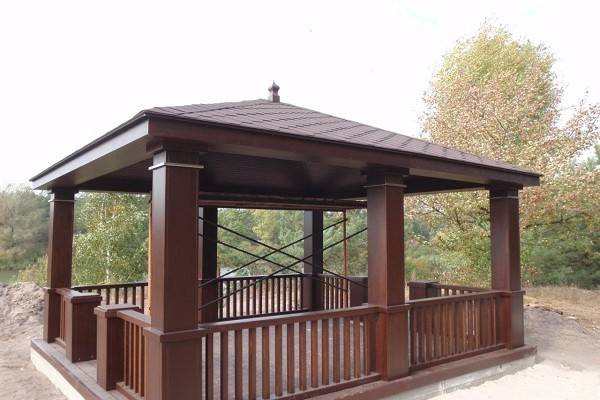
Varnish decorative means
Perfectly smooth surfaces, pre-treated with primer, are exposed with varnish coatings. Manufacturers produce several types of materials:
- XB varnishes for tinting. Popular for their pleasant brown shade and convenient packaging. The disadvantage of using formulations is the difficulty of creating a uniform layer. In addition, the varnish is quite toxic.
- yacht or parquet varnish is distinguished by the ability to create strong and durable protection against UV radiation. They are applied exclusively to clean new wood.
The best way to paint the gazebo is for you to choose, as it should fit into the overall landscape design of the yard.
How to paint a gazebo correctly?
If you want to get a gazebo that will attract attention, you need to prepare for coloring. Before starting to paint the first layer, the wood is cleaned of the smallest adhering particles.
It can be dust, dirt, sawdust.
If the gazebo was previously painted, all previous layers of paint are removed.
In the event that the paint has not peeled off and is combined with the new version, it is enough to wash it with water and baking soda. Severely damaged paint is removed with a spatula; sometimes the wood is burned with a blowtorch or a special remover is used. Don't forget to clean and putty the surface!
In the event that the gazebo is made of new wood, you need to remove all the knots, make cuts in the cracks, otherwise the tree will begin to deform. The painting should be started on the dried material. You can use brushes, rollers, or, if you have funds, use spray paint.
It is imperative to apply several layers to increase the durability of the painting, and not to restore it annually. After the first layer has dried, you can continue painting.
When equipping a personal plot, arbors are often erected from wood. Lightweight construction not only decorates the site, but also performs useful functions.
In order for the gazebo not to collapse from the effects of atmospheric precipitation, the action of sunlight and a crosswind, a protective coating of wooden structures is required. The gazebo can be painted with water-repellent paint or varnished with wood. Careful care of the gazebo will extend its service life up to 10 years. In this case, the applied coating will act as an antiseptic.
Floor painting and treatment rules
The floorboards of the gazebo must withstand constant mechanical stress. This means that a more stable type of paint will be needed for it. It can be acrylic, latex or any other of your choice. If this is your first time painting a gazebo, make sure the wood is dry. The admissible humidity should not exceed 20%. If it rained or for some other reason the tree is saturated with moisture, then you need to wait a couple of weeks until it dries completely.
Did you know? The first varnishes were developed by the ancient Egyptians and combined an organic dye with an inorganic mineral base. The result is a stable, insoluble compound.
Check the wood surface and remove anything that might be sticking out of it: nail, metal clip, chipped edge. Chips must be cleaned before further processing. Then you need to apply a primer and move on to painting
It is important to paint the material evenly during application. Leaving a thicker layer in one place creates a disproportionate shade and looks sloppy
If you put too thick a smear, smooth it out. Leave to dry for 24-72 hours, depending on the type of paint. The drying speed is also influenced by the air temperature.

Several different methods are available for painting wood. Therefore, before deciding what is right for your gazebo, study the information about varnishes and paints, evaluate their capabilities and make a choice. Correctly selected products will help preserve the aesthetic appearance of the surface and protect the floor from environmental influences.
Selection of paint for different wood
New tree
For a fresh gazebo, transparent paint is well suited. It will accentuate the wood pattern (timber, log or board), and also create a protective layer on the new material.
Gazebo with transparent wood color
For these purposes, you can use the same transparent antiseptic, which in some cases will look even more interesting than ordinary paint.
With remnants of old paint
If you decide to renew the paint coat on your gazebo, then it is advisable to use the same coloring agent as before. In most cases, this is impossible, since the gazebo could stand for decades and you just now decided to "refresh" it. In this case, we act like this:
- Remove the top layer of paint as much as possible. We are not afraid to damage the wood, so we use a brush with a metal bristle.
- I would still treat with an antiseptic after that if you managed to remove most of the residues, but this is not critical.
- We cover the tree with an opaque paint similar in color to the previous one.
Painting wood with a brush
Unedged boards and old wood
Since the structure of the wood is uneven, it is necessary to hide it as much as possible. For this we need a thick layer of opaque paint.
Green painted gazebo
It is not particularly pleasant to paint such material, since the consumption is large and it lays down with problems, but they have not yet found a better way.
Requirements for the material of the wood floor covering
Wood is one of the most environmentally friendly finishing materials. It is strong, easy to handle and durable. But due to external factors, the lifespan of wooden floors is reduced. The flooring on an open veranda should be treated with some kind of paint and varnish material.
Did you know? The most useful, even medicinal, are considered floors made of pine or juniper wood. Thanks to essential oils, the material purifies the air and saturates it with useful phytoncides.
The coating must protect the board from the following factors:
- fungi and insects;
- moisture;
- cold;
- fire.

Non-collapsible structures in autumn and winter are exposed to moisture and frost. Over time, this leads to deformation and loss of wear resistance. In addition, moisture contributes to the development of fungi that soften the floor into dust. The bark beetles also reduce the service life, eating holes and whole tunnels in wooden floorings. Protection against accidental fire in the presence of a fireplace will not be superfluous.
Also learn how to glaze a veranda with soft windows with your own hands.
Another important nuance is that you need to choose a paint for the type of wood. On sale there are varnishes and impregnations that imitate the color and texture of the types of wood used in construction. Therefore, if you do not want to lose the natural look of the board, but only to strengthen and emphasize the structure of the flooring, give preference to such materials. If desired, the color of the floor can be made harmonious in relation to the interior, terrace furniture.

Wood
Before painting a tree, you should carefully study the condition of the boards from which the structure is made. They can be conditionally divided into 4 groups:
- New and processed board. Such a coating is dry, carefully sanded, and has a light color. It can be stained or any other protective coating.
- New raw board. A poorly sanded board cannot be stained evenly. The result is an uneven coating, so before you start painting, you need to process the material.
- A perennial burned-out board can only be painted with dense colored paints.
- Wood that has already been painted before. Before applying the coating, it is worth finding out what the composition of the previous paint was so that the new layer does not curl up.
Wood coatings are divided into several types:
- Transparent - distinguish between water, oil and varnish impregnations. The most famous are olive, acrylic and wood stain.
- Opaque are various enamels intended for application to the facade of a building in the country, as well as paints based on polymers.
Protective equipment
Basically, impregnations are divided into the following groups:
- Saline solution - protects the material from mold and fire. Experts recommend choosing it if there is a barbecue in the gazebo. A feature of the solution is the difficulty of its penetration into a solid material, therefore impregnation must be applied under high pressure.
- Water-based products are great for finishing. They prevent the growth of fungus and do not allow moisture to pass through. The solution is easy to apply even with a brush.
Among the many solvent-based impregnations, it is better to choose colored ones - they will help to immediately decorate the gazebo. Such compounds quickly penetrate the structure of the tree.
Oil-based impregnations are used as topcoats.
Tinting
Gazebos are built mainly from pine logs, the natural color of which is very light. Such a tree and similar species should be painted with a protective coating that gives the logs a light brown tint. This product is based on a tinting pigment that enhances the natural beauty of the tree. Most often, tinting is found in the form of primers, they need to be applied only on a pre-treated smooth base.
Paints
The coating is based on polymers. There are the following types of paints:
- Acrylic. Non-toxic, diluted with water before application. Designed for painting wood in a specific color. If latex is present in the composition, then the coating will be glossy, and a film will appear on the surface that does not allow moisture to pass through and prevents mechanical damage.
- Silicone. The paint contains resins and silicone components. Such a coating is called self-cleaning, because after drying, dust cannot settle on the surface. The paint is waterproof, but breathable.
- Silicate. They are characterized by increased moisture resistance. The peculiarity of the paint is that it should be applied on a surface cleared of other coatings.
- An alkyd coating is expensive, but it reliably protects the tree from atmospheric factors. The paint should be thinned with a solvent before use.
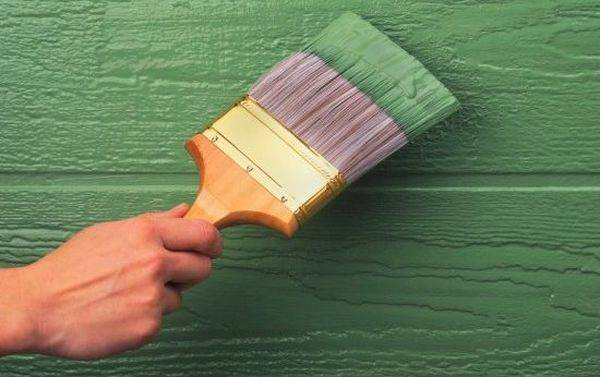
Lucky
Varnishes are completely transparent coatings. They can be divided into several types:
- With toning effect. The product contains toxic substances that are harmful to humans. It is necessary to apply varnish on a wooden surface in layers, while the previous layer must be completely dry. This varnish has several drawbacks: it is difficult to apply, exfoliates upon contact with water, becomes cloudy over time. If there is a desire to change the coating, it should be completely removed from the surface.
- Parquet or yacht coverings are completely transparent and waterproof. There are glossy, semi-matt and matt varnishes on the market. Average service life of varnished coatings for floors and walls is from 5 years. Some manufacturers add components to the varnish that make it resistant to sun exposure.
How to paint a wooden gazebo?
Painting a wooden gazebo takes place in several stages:
- First of all, prepare everything you need for work (round brushes, metal brushes, sandpaper, flange brushes, primer, antiseptic, varnish / paint / mastic, etc.).
- The surface of the wood is cleaned and sanded.
- All details of the gazebo structure are covered with special soil compounds. The primer is applied in several layers (the next one after the previous one has completely dried).
- After the primer has dried, paint or mastic is applied to the details of the gazebo. The topcoat is applied in two layers. For indoor and outdoor work, select compositions that are suitable for their characteristics.
The wooden gazebo can be painted in any color, the main thing is that it is in harmony with the surrounding landscape
How to paint a wooden gazebo is an individual choice for everyone. Someone makes their country house bright, using different colors of the palette of oil paints, others preserve the natural shade of the wood and paint the surface without hiding the texture.
All wood products, including summer cottages, are subject to decay. Thanks to modern processing materials - paint and antiseptic, you can extend the life of your building for decades.

The idea of a dark gazebo from "Maxim"
- How to paint the wooden parts of the gazebo?
- What color?
- How to make it beautiful?
First of all, you need to decide on the type of paint, which will vary depending on the type of wood.
Next, we'll look at protecting walls, pillars, and wood floors with an antiseptic. At the end, the most interesting paint colors will be listed.
At first antiseptic
, then impregnation
and at the end oil film with color "Aquatex Extra"
.

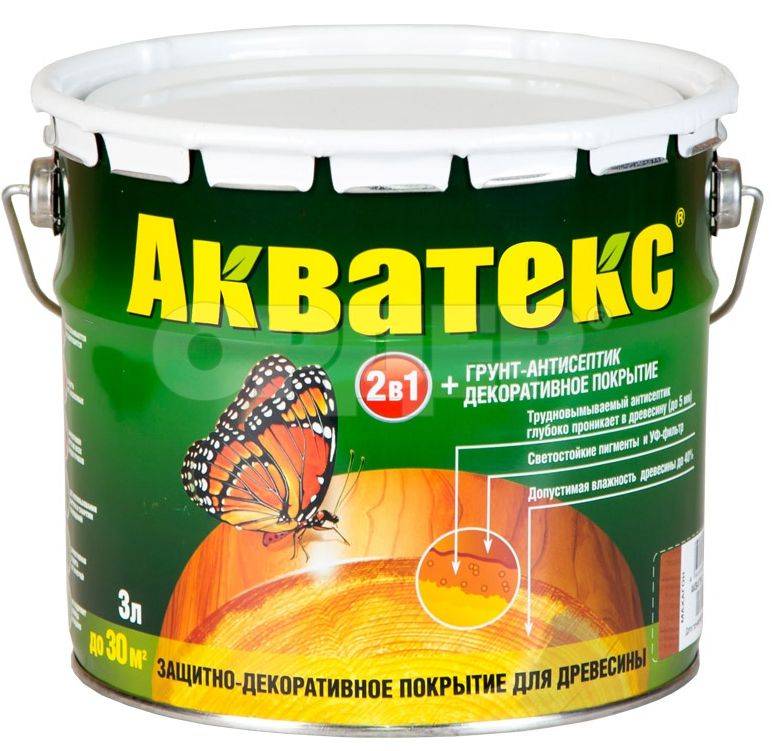
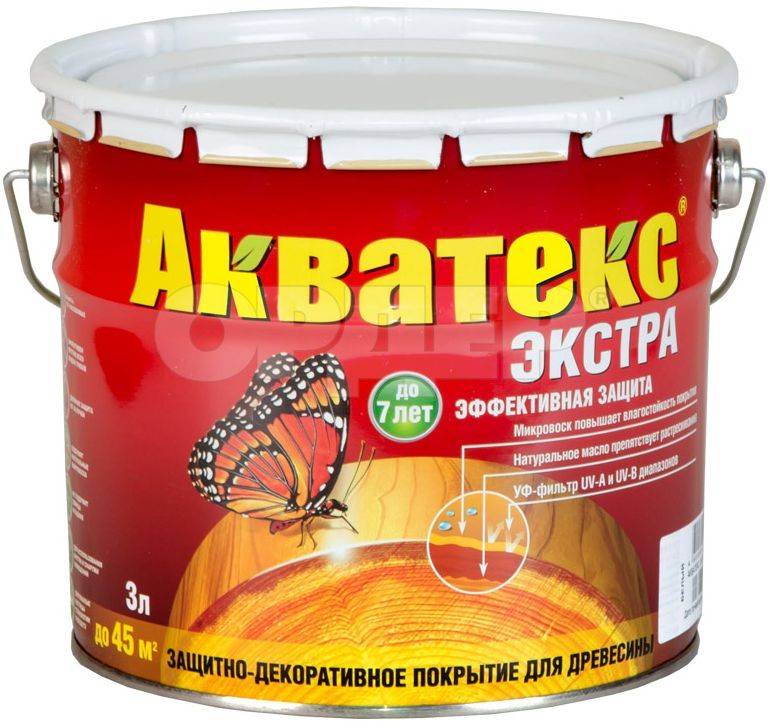
Aquatex wood preservatives are widely represented on the market. This is the highest quality, relatively inexpensive and convenient approach that is used by the overwhelming majority of summer residents.
The gazebo painting process is carried out in three stages:
The first layer of wood is treated with Aquatex antiseptic
... It kills most of the harmful microorganisms, mold and mildew.
The second layer is Aquatex impregnation
... A breathable film is created that allows the tree to breathe
This is important for wet pine, which will dry and crack during use.
The third layer is Aquatex Extra oil film. Final processing comes with a color scheme, so you can choose a color for your gazebo
True, in most cases, everyone prefers either a transparent or a dark shade.

